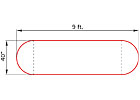
Figure 1
Tanks are an integral part of most hydronic, solar thermal, geothermal and solid fuel heating systems. In many systems, they are used to produce and store domestic hot water. They are also used as a buffer between the rate of heat output from a heat source and the rate of heat release by a distribution system. In solar thermal systems, tanks are used to hold the drainback volume of collector fluid, as well as to contain the expansion volume of heated fluids.
In larger HVAC systems, tanks may be used to store chilled water or ice produced using off-peak electricity. On the input end of heating systems, tanks are used to store fuels such as propane, fuel oil and wood pellets.
Given all these uses, designers need a way to quickly relate the dimensions of a tank to its volume. This can help determine the feasibility of locating a tank of a given shape in a particular space. It can also be used to determine the weight of a tank and its contents.
This month we’ll look at several common tank shapes as well as formulas that can be used to calculate their volume and partial volume, the latter being the amount of fluid in the tank when it’s only partially filled.

Formula 1
Where:V = volume of fluid in tank (gallons)
D = diameter of tank (inches)
h = height of fluid in tank (inches)
To calculate the total volume of the tank, set the value for (h) to the overall tank height (H).
Here’s an example: Find the total volume of a vertical cylindrical tank, with flat ends, having a diameter of 24 inches and a height of 6 feet.


Figure 2
Volume Between Cylinders
Sometimes designers need to know the volume between two cylinders of different sizes (see Figure 2). An example would be estimating the volume of foam insulation between an inner tank and an outer shell. The volume between cylinders is determined by subtracting the volume of the inner tank from that of the outer shell (see Formula 2).
Formula 2
Where:VBC = volume of space between cylinders (ft3)
D = diameter of OUTER shell (inches)
d = diameter of INNER tank (inches)
H = height of OUTER shell (inches)
h = height of INNER tank (inches)
Here’s another example: How many cubic feet of insulation is required to put a 3-inch thick layer of insulation around a flat-ended cylindrical tank that’s 24 inches in diameter and 72 inches tall?
Solution: For a 3-inch-thick layer of insulation all around the inner tank, the diameter of the outer shell would be 6 inches greater than the inner tank (3 inches on each side). Likewise, the height of the outer shell would be 6 inches greater than the height of the inner tank. With these dimensions, Formula 3 calculates the volume between these cylinders as:

Formula 3

Figure 3
Lawn Sausages
That’s my affectionate name for larger propane storage tanks mounted above grade. They’re made by welding two hemispherical or elliptical domes to a central cylinder as shown in Figure 3.The total volume of such a tank is found by adding the volume of the cylindrical section to the volume of the two end domes. Formula 4 determines the total volume when the end domes are hemispheres.

Formula 4
Where:V = volume of tank (gallons)
r = radius of tank and domes (inches)
L = length of cylindrical portion of tank (inches)

Figure 4


Figure 5


Since there are 7.4805 gallons in a cubic foot, this converts to:
In this case, 35.9 cubic feet of insulation is required.

Figure 6
A Real Challenge
Sometimes you might need to calculate the amount of liquid in a horizontal cylinder tank, with various types of ends, based on the height of liquid in the tank. This is not as simple as the vertical cylinder, because the width of the fluid surface in the tank varies constantly as the tank is filled.The last time I really studied the mathematics to handle this was more than 30 years ago. Fortunately, during that time, I was blessed with a new resource - my son Dale, the Siegenthaler family mathematician.
Dale worked out three formulas for me:
- The volume of a horizontal cylinder tank with flat ends.
- The volume of a horizontal cylinder tank with spherical ends.
- The volume of a horizontal cylinder tank with elliptical ends.
Although it’s possible to evaluate these formulas with any $10 scientific calculator, I don’t recommend you do so unless you’re very comfortable with such a calculator. Instead, program these formulas into EXCEL or other spreadsheet or, even better, use the free tank volume calculator software available atwww.arachnoid.com/tank_volume.
1. The volume of a horizontal cylinder tank with flat ends (Figure 6).

V = volume of liquid in tank (gallons)
h = height of liquid in tank (inches)
R = radius of cylinder (inches)
L = length of cylinder (inches)

Figure 7

V = volume of liquid in tank (gallons)
h = height of liquid in tank (inches)
R = radius of cylinder (inches)
L = length of cylinder (inches)

Figure 8

V = volume of liquid in tank (gallons)
h = height of liquid in tank (inches)
R = radius of cylinder (inches)
L = length of cylinder (inches)
r = minor radius of dome (inches)

Figure 9
I hope one or more of these formulas will come in handy the next time you need to calculate the volume, or partial volume, of a tank.
